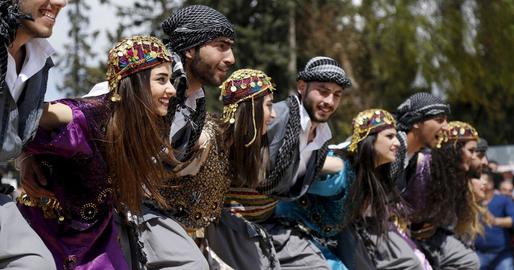March 10 is a significant date for the Kurdish community, as it marks the observance of "Kurdish Dress Day."
On this day, a vibrant display of Kurdish tradition unfolds, with countless individuals proudly donning their traditional attire in workplaces and public spaces in the Kurdistan region.
While the exact origins of this commemoration of traditional Kurdish clothing remain unknown, recent years have witnessed a deepening of its significance among Kurds.
Government officials in Iran have embraced the occasion, joining their fellow citizens in wearing Kurdish clothes as a mark of solidarity and cultural pride.
🎥 بیستم اسفند برابر با دهم مارس روز لباس کردی است. در این روز پوشیدن لباس کُردی در ادارات و اماکن عمومی جزیی مهم و لاینفک از فرهنگ مردم است، اما امسال استاندار کردستان در همراهی با مردم شب گذشته در پیامی از تمام کارمندان دولتی خواست تا با لباس کُردی در محل کار حاضر شوند که… pic.twitter.com/KyjVZs7DQZ
— ایران وایر (@iranwire) March 11, 2024
What began as a simple act of cultural expression has evolved into a cherished tradition deeply rooted in the fabric of Kurdish identity.
This year, the governor of Kurdistan province further solidified its importance by calling upon all government employees to wear Kurdish attire to work—a gesture warmly embraced by the people.
Beyond the workplace, ordinary citizens also enthusiastically embraced the tradition, adorning their profiles with images of them in Kurdish attire and sharing the day's cultural significance online.
Kurdish attire, rich in colors and stitching styles, holds a special place in the wardrobes of both men and women.
The women's clothing displays a variety of designs influenced by personal preferences and tailors. Typically comprising the "Cross" (shirt), "Pashtuin" (waist shawl), and "Lechak" (scarf), these ensembles may feature additional accessories.
Meanwhile, the men's attire, consisting of the "Kewa" (shirt), Pants, and "Pashtuin" (waist shawl), offers a blend of tradition and personal style.
Often complemented by distinctive footwear like Kalash shoes, these outfits reflect a deep-rooted connection to Kurdish heritage.
Beyond their cultural significance, Kurdish attires also play a pivotal role in the region's economy.
Tailors specializing in Kurdish clothing are highly respected in society and contribute to the middle-class economy alongside cloth merchants.
Their skill sustains a thriving market in Kurdistan's cities.
In recent years, the resurgence of interest in Kurdish clothing has sparked a notable increase in female participation in the industry.
Women artisans, skilled in tailoring, not only contribute to their families' livelihoods but also play a vital role in preserving and promoting Kurdish culture.
Through workshops and entrepreneurial endeavors, they breathe new life into age-old traditions and ensure their legacy endures for generations to come.
visit the accountability section
In this section of Iran Wire, you can contact the officials and launch your campaign for various problems


























comments